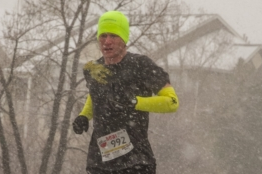Last October, I signed up for the 2024 Virginia 10 Miler which was held this past Saturday, the 28th. This is a somewhat legendary, 10-mile road race in Lynchburg, VA, the town where I grew up. The winning times have been under 50 minutes, or sub-5 minute mile pace. It features over 700 feet of total climbing and the course has a steady diet of hills, including the infamous “Farm Basket Hill,” a grueling 1.5 mile net climb at the end of the race.
Though I began running earnestly when I was 14, I had never run the 10-Miler. Among running cross-country, being out of town for college, etc. it was something I’d never been able to fit in. The 2024 edition was the 50th anniversary of the race and I figured that it was as good a time as any to give it a go. It was going to pose some challenges.
Where I live in Colorado is relatively flat. There are slight ascents and descents and a few large hills, but nothing close to the constant grind of hills I would face on the 10-miler course. So, I adjusted my training routes. I made sure to incorporate a set of bigger hills near my house into more of my training runs and I did two types of ten-mile training runs. One was where I would run net downhill on the way out and then have net uphill on the way back. This helped approximate the profile of the 10-miler course. The second type was including long sets of grueling hills into the run. These training runs generally felt terrible but I kept in the back of my mind that it would (hopefully) pay off on race day.
I also worked on pacing. The 10-miler is net downhill on the first half and at sea level and I knew that it would be tempting to go out too fast. I worked to moderate my pace on the first half of my training runs and thus save some fuel for the second half, especially those runs where I was finishing coming back uphill.
Finally, I also began incorporating a three-part race strategy: RBR, or Relax, Breathe, Race.
Relax: the goal was to focus on relaxing my body north of my waist. There’s no need to waste energy tensing up muscles that I’m not directly using to churn out the miles. This is something I’ve been working on for a couple of years and I continued to emphasize it.
Breathe: In a book I highly recommend, The Track in the Forest, it talks about how one of the coaches of 1968 Olympic team encouraged his athletes to incorporate heavy exhalation into their racing. The idea is that as distance runners, we’re sucking in high levels of oxygen and that it’s beneficial to our bodies to also try and release some of the extra CO2 that we’re building up. This is easier said than done since we rely on taking in the oxygen. What I focused on was using downhills, where I don’t need to take in as much air, as opportunities to do one to three sets of deep, forced exhales, depending on the length of the hill, to help keep everything in my lungs a little cleaner. Towards the bottom of the hill, I would then do several deep inhales to replenish the air before starting on the next climb.
Race: I’m an easily distracted daydreamer. It’s common for me to lose focus on a long run while thinking about any number of topics. While this can help me to forget about the pain of a training run or race, I also can lose track of things I want to think about related to my strategy. For this race, I simply tried to make sure I was keeping my focus sharp.
My training went relatively well, minus a few hiccups, so when I showed up at the start line, I had to hope that it was sufficient to run the race I wanted. How did that go? Stay tuned for my next post…

Running anecdotes, running food reviews, some race coverage, and more